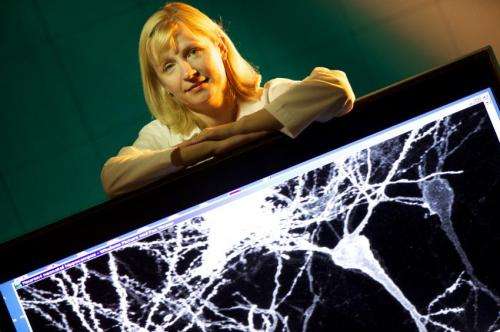Study links enzyme to autistic behaviors

Fragile X syndrome (FXS) is a genetic disorder that causes obsessive-compulsive and repetitive behaviors, and other behaviors on the autistic spectrum, as well as cognitive deficits. It is the most common inherited cause of mental impairment and the most common cause of autism.
Now biomedical scientists at the University of California, Riverside have published a study that sheds light on the cause of autistic behaviors in FXS. Appearing online today (July 23) in the Journal of Neuroscience, and highlighted also on the cover in this week's print issue of the journal, the study describes how MMP-9, an enzyme, plays a critical role in the development of autistic behaviors and synapse irregularities, with potential implications for other autistic spectrum disorders.
MMP-9 is produced by brain cells. Inactive, it is secreted into the spaces between cells of the brain, where it awaits activation. Normal brains have quite a bit of inactive MMP-9, and the activation of small amounts has significant effects on the connections between neurons, called synapses. Too much MMP-9 activity causes synapses in the brain to become unstable, leading to functional deficits.
"Our study targets MMP-9 as a potential therapeutic target in Fragile X and shows that genetic deletion of MMP-9 favorably impacts key aspects of FXS-associated anatomical alterations and behaviors in a mouse model of Fragile X," said Iryna Ethell, a professor of biomedical sciences in the UC Riverside School of Medicine, who co-led the study. "We found that too much MMP-9 activity causes synapses to become unstable, which leads to functional deficits that depend on where in the brain that occurs."
Ethell explained that mutations in FMR1, a gene, have been known for more than a decade to cause FXS, but until now it has been unclear how these mutations cause unstable synapses and characteristic physical features of this disorder. The new findings expand on earlier work by the research group that showed that an MMP-9 inhibitor, minocycline, can reduce behavioral aspects of FXS, which then led to its use to treat FXS.
To further establish a causative role for MMP-9 in the development of FXS-associated features, including autistic behaviors, the authors generated mice that were missing both FMR1 and MMP-9. They found that while mice with a single FMR1 mutation showed autistic behaviors and macroorchidism (abnormally large testes), mice that also lacked MMP-9 showed no autistic behaviors.
"Our work points directly to MMP-9 over-activation as a cause for synaptic irregularities in FXS, with potential implications for other autistic spectrum disorders and perhaps Alzheimer's disease," said Doug Ethell, the head of Molecular Neurobiology at the Western University of Health Sciences, Pomona, Calif., and a coauthor on the study.
The research paper represents many years of bench work and effort by a dedicated team led by the Ethells. The work was primarily done in mice, but human tissue samples were also analyzed, with findings found to be consistent. Specifically, the work involved assessing behaviors, biochemistry, activity and anatomy of synaptic connections in the brain of a mouse model of FXS, as well as the creation of a new mouse line that lacked both the FXS gene and MMP-9.
FXS affects both males and females, with females often having milder symptoms than males. It is estimated that about 1 in 5,000 males are born with the disorder.
The Ethells were joined in the study by UCR's Harpreet Sidhu (first author of the research paper), Lorraine E. Dansie, and Peter Hickmott. Sidhu and Dansie are neuroscience graduate students; Hickmott is an associate professor of psychology.
Next, the researchers plan to understand how MMP-9 regulates synapse stability inside the neurons. They also plan to find drugs that specifically target MMP-9 without side effects such as new tetracycline derivatives that are potent inhibitors of MMP-9 but lack antibiotic properties.
"Although minocycline was successfully used in clinical trial in FXS, it has some side effects associated with its antibiotic properties, such gastrointestinal irritation," Iryna Ethell said. "We, therefore, plan to test new non-antibiotic minocycline derivatives. These compounds lack antibiotic activity but still act as non-competitive inhibitors of MMP-9 similar to minocycline."
More information: Journal of Neuroscience, 23 July 2014, 34(30): 9867-9879; DOI: 10.1523/JNEUROSCI.1162-14.2014














